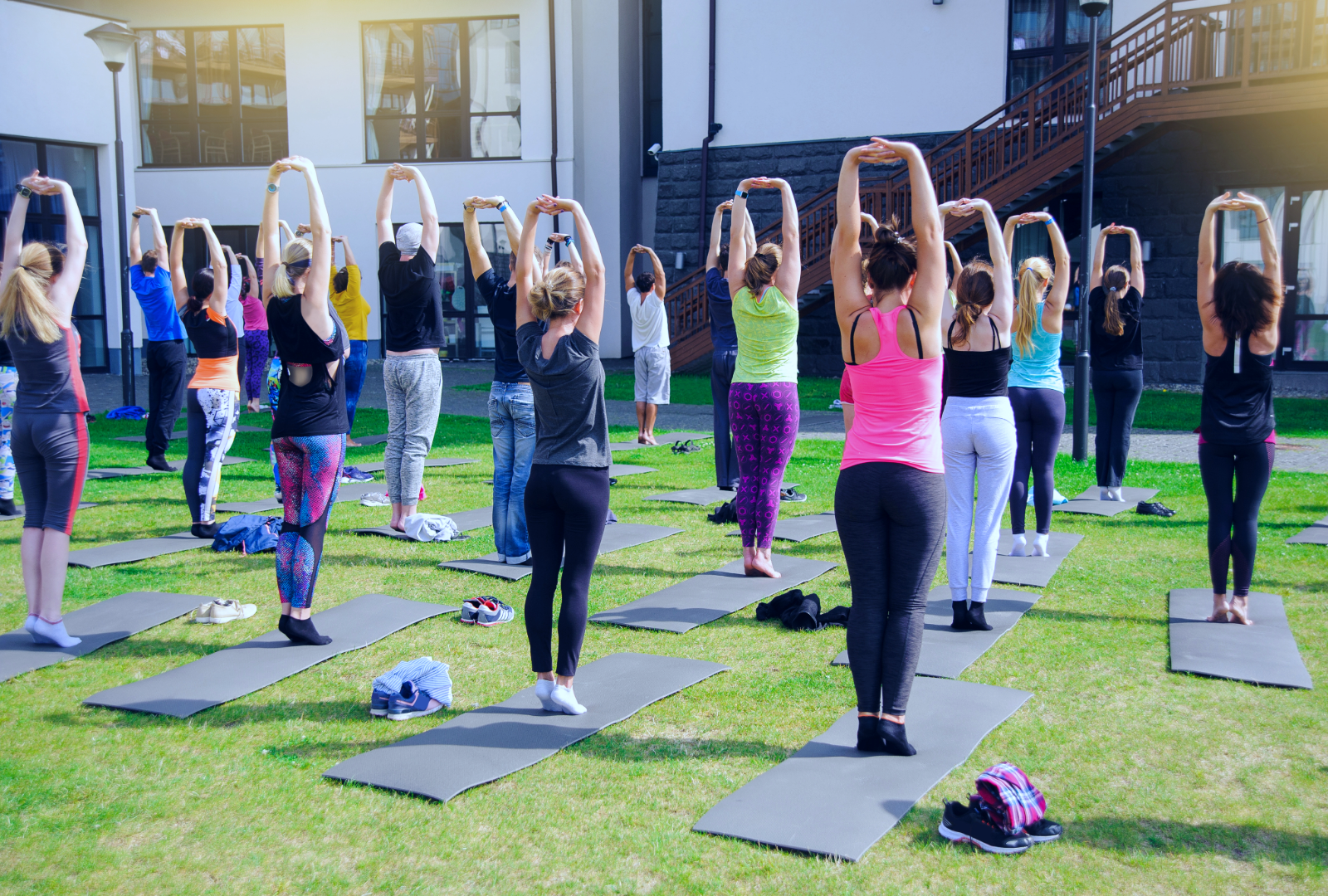Coming Soon: E-book about Kundalini Yoga - Sign up here to be among the first to get it!
So, you’ve decided to deepen your yoga journey. Your mat feels like home and each pose a familiar friend. You’re ready for the next step – how to choose a yoga teacher training. It’s an exciting decision, right? But also a bit daunting.
The world of Yoga Teacher Training (YTT) can feel like navigating through an intricate maze with many paths branching out in all directions – 200-hour courses, 300-hour advanced trainings, specialized styles… it’s easy to get lost.
How can I make sure to find the right path? Which path is mine?
Whether it’s getting to grips with different yoga styles, balancing cost factors, or pinpointing the right course for you, this guide is designed to navigate through your quest. You’ll reach the end of this intricate journey having discovered your ideal YTT program.
Table Of Contents:
- Understanding Yoga Teacher Training Programs
- Identifying Your Yoga Style and Teaching Method
- Considering Time and Availability
- Evaluating Yoga Schools and Instructors
- Assessing Curriculum and Content
- Considering Cost and Location
- Seeking Recommendations and Reviews
- Balancing Personal Preferences and Intuition
- FAQs in Relation to How to Choose a Yoga Teacher Training
- Conclusion
Understanding Yoga Teacher Training Programs
Diving headfirst into the world of yoga teacher training can feel like navigating a labyrinth. Navigating the right path through this labyrinth requires careful consideration.
The various yoga teacher trainings available are not all the same; it’s essential to recognize this. A good program should be comprehensive and robust, incorporating both theoretical knowledge and practical experience.
1. Diving into the Structure of Yoga Teacher Training Courses
A typical course might include options for 200-hour or 300-hour certifications – but what does this mean? Simply put, these numbers represent hours spent in study. Many programs even offer advanced studies leading up to a total of 500-hours certified by Yoga Alliance.
Here’s an interesting fact: Small studios often depend on their own teacher trainings as important sources of revenue. Larger ones may require teachers to take their specific courses before hiring them.
2. Identifying Your Preferred Style and Teaching Methodology
To choose your path wisely, it’s essential to identify which style resonates with you – whether that’s Hatha, Ashtanga Vinyasa or something else entirely. Each style requires different teaching methodologies and hence different types of training. If you are interested in learning more about each styles, you can read my guides Vinyasa, Hatha, Kundalini and Ashtanga.
Bear in mind that Yin Yoga or Yoga Nidra are usually specific trainings that can be undertaken after o during the basic 200hr course.
3. Your Time Availability Matters Too
Balancing work life while chasing your passion can be tricky. Most people opt for weekend-based standard format trainings which allow them flexibility without compromising on learning depth. Nowadays, it is possible to undergo Teacher Training online. Many schools now offer remote courses that can be completed at your own pace, with certain portions of the course conducted via Zoom alongside fellow students.
Finding The Right School And Instructor Is Crucial
In addition to curriculum content, another vital aspect is assessing quality—of schools and instructors alike—is to ensure that it provides a recognised certificate, such as one that enables registration with Yoga Alliance. This certification will provide credibility if you are interested in pursuing a teaching career.
Finally, Trust Your Intuition.
In the end, remember that choosing a yoga teacher training is also about personal resonance. As much as you evaluate practical aspects like time availability or cost-effectiveness, it’s equally important to trust your gut feeling.
When choosing a yoga teacher training, it’s not just about the program – it’s also about you. Consider the structure of courses, your preferred style and teaching methodology, as well as your time availability. Don’t forget to assess the quality of schools and instructors too. But remember: trust your intuition.
Identifying Your Yoga Style and Teaching Method
Finding your unique yoga style is a crucial first step in choosing a teacher training program. Are you drawn to the vigorous sequences of power yoga or do you find peace in the gentle stretches of yin yoga?
Your choice here will help guide your teaching method, creating an authentic alignment between what you practice and what you’ll teach.
Finding Your Niche in Power Yoga or Yin Yoga
Each yoga style, whether it’s ashtanga vinyasa, power, or yin, has its own foundational teachings that shape not just the physical practice but also philosophy and methodology.
You need to dive deep into understanding these nuances. Each teacher training program will have a different lineage, lens, and focus which greatly influence how they approach their chosen styles.
The dynamic nature of power yoga makes it more physically demanding – think strength-building poses with swift transitions. On the other hand, yin yoga offers slow-paced postures held for longer periods promoting flexibility and relaxation.
This is why it’s essential to explore various teaching methods within each style before making any decision. A great way to start? Get on that mat.
If after several sessions one particular style resonates with your spirit more than others – bingo. You’ve found where you belong.
Learning Styles: Adaptability Is Key
In addition to identifying your preferred form of yoga itself – there’s also learning about different ways we absorb knowledge; visual (seeing), auditory (hearing), reading/writing (writing notes) kinesthetic(hands-on).
An ideal trainer adapts their instruction techniques according to these varied learning styles. So, it’s good idea to question how adaptable your potential trainers teach.
Ultimately, understanding your yoga style and teaching method is about honoring what feels true for you because that authenticity will resonate with every student who steps into your class.
Know Your Yoga, Find Your Niche: Unearth your unique yoga style to guide your teaching path – be it the intensity of power yoga or tranquility of yin. Delve into their foundational teachings and understand the nuances before you pick a teacher training program.
Different Strokes for Different Folks: Everyone has their own unique approach and perspective. What works for one person may not work for another. That’s the beauty of diversity.
Considering Time and Availability
When choosing a yoga teacher training program, it’s crucial to consider your time constraints. You might be juggling work or family commitments alongside this new journey.
Balancing Work with Weekend Trainings
The good news is that many yoga trainings offer flexible schedules to accommodate different lifestyles. If you’re employed full-time, weekend-based standard format trainings can let you continue working while expanding your yoga knowledge.
A typical day in such programs includes practice teaching sessions along with theoretical classes. These are spread over several weekends instead of crammed into an intensive few weeks. This schedule allows for more absorption of the material without causing burnout.
This setup also lets you maintain balance between regular job duties and the rigors of teacher training courses, preventing any one aspect from overshadowing the other.
If however, time isn’t much of a constraint for you then perhaps an intensive format could suit better. Destination retreats often provide immersive experiences where students live and breathe yoga for 2-6 weeks straight – truly diving deep into their physical practice as well as learning about yogic philosophy and lifestyle at a rapid pace.
Yoga Alliance, offers detailed listings on both formats allowing potential teachers to make informed decisions based on their unique circumstances.
Remember, becoming a registered Yoga instructor shouldn’t feel like running against the clock but rather unfolding within its rhythmic ticks.
Evaluating Yoga Schools and Instructors
Selecting the ideal yoga school and teacher can be pivotal in your quest to becoming a certified yoga instructor.
Not all yoga schools are equal; bear this in mind. Each has its unique mission statement, which is essentially their guiding principle. This tells you what kind of skills they want their trainers to develop.
The Importance of a Registered Yoga Teacher Certification
You may ask why should I care about certification? Well, having a registered yoga teacher certification ensures that the program adheres to certain standards set by professional bodies like Yoga Alliance.
This means you’ll get comprehensive training covering all aspects – from asanas (postures) to pranayama (breathing techniques), meditation, anatomy and physiology, teaching methodology and even yogic philosophy.
Beyond just ticking off boxes for accreditation though, make sure your chosen school aligns with your personal goals as an aspiring yoga teacher. Ask yourself: Does this school resonate with my style? Do I agree with their approach?
Sizing Up Your Prospective Instructor’s Reputation
Your relationship with your prospective instructor plays a pivotal role too. Are they respected within the community? What do former students have to say about them?
A great way is through reviews or word-of-mouth recommendations. Don’t hesitate asking around or checking online forums for insights on different instructors’ teaching styles.
An inspiring instructor can help deepen your understanding of yoga while nurturing self-confidence so you feel ready when it’s time to step onto the mat alone.
Assessing Curriculum and Content
A crucial step in picking a yoga teacher training is to assess the curriculum thoroughly. When and if you have identified multiple yoga teacher training schools, ask for a curriculum and check that the theoretical components are balanced with enough teaching practice. An excellent curriculum is like the components of a delicious meal – all necessary elements must be present and of top quality.
Decoding Yoga Sutras in Your Training
The ancient texts like Yoga Sutras provide rich insights into the philosophy behind asana practice. A comprehensive course will not only teach you poses but also delve deep into these timeless wisdom nuggets.
This knowledge isn’t just academic; it enriches your teaching style too. When you understand why certain practices exist or what their benefits are, that understanding reflects in how effectively you can guide your students through their journey on the mat.
To get an idea about this aspect, don’t hesitate to ask about learning objectives during initial discussions with potential schools. It’s akin to peeking at the recipe before deciding if you want to cook that dish.
You’ll learn so much more than sequences of postures – expect elements such as anatomy lessons relevant for yogic movements and breathing techniques known as pranayama. Ethics around yoga teaching could form another important part of this mix – after all, being a yoga instructor means holding space responsibly for people seeking physical wellbeing along with mental peace.
Dig deeper by asking questions about each component: How many hours does the program dedicate towards practical versus theory classes? Is there any focus on specialty areas like prenatal or senior citizen friendly yoga?
Considering Cost and Location
When it comes to choosing a yoga teacher training program, cost is a significant factor. Not only the tuition fee, but also any journey costs should be taken into account if you’re looking at a course away from home.
Your budget can make or break your decision. So before you fall in love with that exotic retreat center halfway across the world, remember: local programs might be more wallet-friendly.
Weighing the Pros and Cons of Local vs. Destination Trainings
Affordability is one major advantage of local trainings; enrolling in a program in your hometown can save on travel costs. But there are other benefits too—like familiar surroundings, proximity to family or friends for support during intensive periods of study—and no jet lag.
If destination trainings appeal to you though—with their allure of learning amidst new cultures or landscapes—you’ll need to account for airfare, accommodation and possibly meal costs as well.
Surely Yoga Alliance-registered courses offered at tropical paradises sound exciting. Just don’t forget to factor these into your total investment calculation when comparing different teacher training options based on location.
You see folks—the journey towards becoming a certified yoga instructor doesn’t have to burn holes through pockets nor does it require crossing seven seas (unless that’s what tickles your fancy.). Consider all elements like comfort level, convenience alongside finances while deciding where you want this transformational experience unfolding.
Remember – whether nestled amidst lush greenery at home turf or under foreign skies filled with unknown stars – both journeys promise personal growth and professional development alike.
Seeking Recommendations and Reviews
Choosing a yoga teacher training program is no small task. Finding the ideal hiking boots for a daring journey is like selecting the perfect yoga teacher training program – you require them to be dependable, strong, and suitable for your individual preferences.
Making Use of Online Reviews
A good starting point? Yoga Alliance’s website. Like an online marketplace filled with reviews about different yoga products, it offers insights into various aspects such as curriculum quality and instructor competence.
The process can feel like shopping on Amazon – you sift through multiple options before finding the right one. Make sure to read reviews carefully; they often reveal essential details about the course structure or teaching methods that might resonate with you.
Leveraging Personal Recommendations
Personal recommendations are another gold mine when looking for reliable programs. They’re akin to having a trusted friend guide us towards their favorite coffee shop – we trust their judgment because they know our taste.
You could ask around in your local yoga community or reach out to teachers whose classes have inspired you in the past. They can give real-life insights into what it’s really like attending certain trainings and help steer clear of any potential pitfalls along this yogic path.
Note:
Please remember not all advice will suit everyone so take time considering these suggestions against your personal preferences too.
Balancing Personal Preferences and Intuition
It’s also about your gut feeling.
Your intuition is a powerful guide when deciding which path to take in your yoga journey.
Trusting Your Gut
The world of yoga is vast, with many styles and teachings. It is essential that the instruction you decide on makes an emotional connection with you as well.
This is where individual inclinations become a factor. Do you love the fast pace of power yoga or do you prefer slow, meditative yin classes?
Perhaps advanced asana practice ignites your passion? Or maybe studying ancient texts like Yoga Sutras lights up your intellectual curiosity?
Dig deep within yourself to discover what really matters to you in this process. That will help steer you towards programs that align more closely with who you are as an individual and future instructor.
Making Choices Based On You.
Your personal choice should be at the heart of any decision regarding your teaching journey – after all, it’s YOUR career we’re talking about here.
If there’s one thing I’ve learned from my own experience through multiple trainings (yes – once wasn’t enough.), it’s that following others’ footsteps may not lead us down our desired paths because everyone has their unique reasons for becoming teachers.
You might find comfort knowing other fellow yogis chose hour YTT programs over weekend-based ones due their busy schedules but remember: this doesn’t necessarily mean same option suits best for YOU.
In end each person different thus so must be our approach choosing right training.
So trust your gut and follow where it leads. Because ultimately, the most fulfilling path is the one that’s true to you.
important thing is to listen to your intuition. Reflect on what style of yoga speaks to you and the type of teacher that inspires you. Keep in mind, it’s not just about mastering poses; it’s also about personal growth and diving deep into this spiritual practice. Don’t rush the decision-making process – take your time, do some research, and most importantly trust yourself because at the end of the day, only you know what feels right for your yoga journey.
FAQs in Relation to How to Choose a Yoga Teacher Training
How do I find a good yoga school?
You’ll want to look for schools that have strong reputations, certified instructors, and a curriculum that aligns with your goals.
What should I look for in a yoga teacher?
Look for teachers who are registered with Yoga Alliance, demonstrate clear teaching methods, show genuine care towards students, and hold substantial experience in their style of practice.
What kind of yoga teacher training should I do?
Your choice depends on your personal preference. From power or yin yoga to vinyasa flow – choose one based on what resonates most with you.
How do I plan a yoga teacher training?
Prioritize understanding the course structure and content first. Then factor in cost, location, and schedule before deciding on an ideal program suitable for you.
Conclusion
Choosing the right yoga teacher training is a journey in itself. It starts with understanding different programs and their structure, diving deep into 200-hour or 300-hour courses.
Remember, your personal style matters. Whether you lean towards power yoga or prefer the quiet intensity of yin yoga, find your niche. Time constraints are real but remember that weekend trainings can help balance work commitments while pursuing this path.
Evaluating schools and instructors takes time too – check for registered certifications and consider curriculum content from practical sessions to decoding Yoga Sutras.
Factor in costs and location when deciding between local versus destination trainings at retreat centers. Reviews play an important role as well – online ones offer insights while personal recommendations give trusted guidance.
Your intuition counts when learning how to choose a yoga teacher training program; it’s about finding what resonates with you personally!
sign up to our newsletter to stay updated with our latest articles




